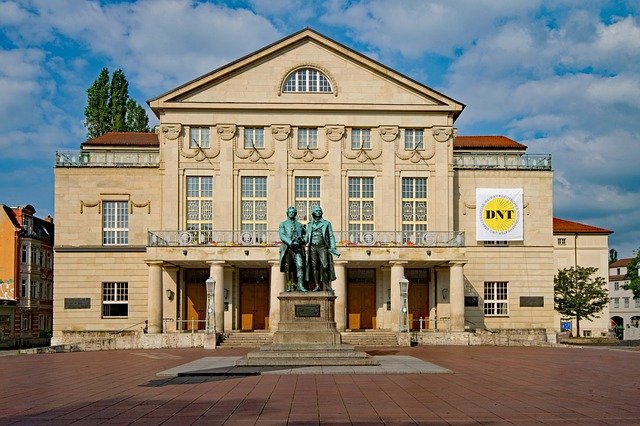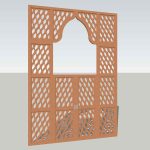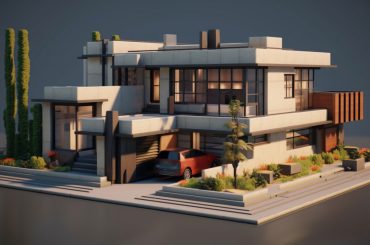Germany is a land of history and violence as to facts and research over the internet, all of our minds go to the mighty Hitler and beer, but it is also recognized as the biggest auto manufacturing country in the world, Germany is famous for its art and culture along with fashion and humanity, of course, the German architecture has a very long journey to look at from influencing most amazing architectures of Europe to creating their own gothic architecture, it is a country to look at when it comes to architecture and the philosophy hidden behinds it.
Historicism is a collective architectural style that is to recreate the historic styles and reestablishs the work of historic artisans, combining different elements can create a completely different style from the former one, from baroque to vernacular everything will come under historicism architecture.
Romanesque Architecture
Romanesque is one of Europe’s most famous and widely recognized architecture by using most ancient Roman elements and characteristics being influenced heavily by the architectural philosophy and style, we can witness that the majority of cathedrals, and symmetries in central Europe are of Italian Romanesque architecture style.
In Germany, it made a great impact during the 6th to 11th century and it led to the creation of many famous architectures in Germany with the Romanesque style, the massive quality of the architecture made it enlarge with time and a rapid adaptation emerged, the thick walls and round arches along with standard sturdy pillars made the architecture more beautiful and astonishing one between peoples, the large towers and barrel vaults with decorative arcading even added spice to the architectural philosophy much greater and acted as its core characteristics.
Basilica of the holy apostles, cologne
It is one of the glorious twelve Romanesque churches (German architecture) around Cologne in Germany, cathedrals are highly influenced by Romanesque architectural style for their usage of elements and characteristics, the Romanesque churches look richer look which made people believe in God even more and the architectural structure stands tall to tell that God is above all.
Gothic Architecture
Gothic is another amazing European architecture that flourished from the cultural capital of world Europe, gothic architecture has its root in the Gothic tribes of Germany and then influenced by various countries across the world, it is a sub-architecture of Romanesque or even we call it as another leaf of Romanesque architecture.
Though the Gothic style is highly influenced by ancient Roman architecture, it chose different elements to show itself unique from all other European architectures, the exaggerated arches with highly increased vaults and enlarged windows made it exceptional and the usage of thin walls with flying buttresses differentiate it from the Romanesque architecture, the stone structures of gothic style made it to look like skyscrapers and reached to heavens
Most of the Gothic architecture is of cathedrals, churches, and some palaces, of course, it is a whole new level of architecture at the time, the French-born art dominated Germany for the time duration.
Heidelberg Castle
The red-painted palace or castle (German architecture) is one fine example and witness of the mighty work of Gothic architecture, though it is extraordinary Gothic architecture renaissance architecture too influenced by its construction through various centuries and kings.
City church, and castle church in Wittenberg are a few other gothic architectural stands in Germany.
Classical (Classicism) Architecture
No matter how advanced the world gets and new trends emerge every single day, the respect for classics still lives and will live till there’s someone to admire and adore it, classical architecture is just out of the boundary in the world of architecture, the influence of ancient Rome and Greek-style made it even more classical then it is and getting adapted by people even who love trends rather than classics.
Vitruvius(Roman architect) played a very important role in making and showing the world what classical architecture it and he never knew that all of the Roman temples were going to use the style at the time, the usage of geometry and columns are core features of the classical architecture and unfortunately, there’s no living architecture is there to witness its beauty but exist in theories alone to give an idea and then birth to the neoclassical architecture style.
Modern Architecture
Modern architecture is a change to every architecture ever found in history, the usage of modern elements like glass and steel influenced highly in modern architecture, and reinforced concrete acted as another major element being used in the construction, it is one of ever longing architecture styles in history and from the establishment of modernism, the entire world adapted to it and even major architecture style use the elements of modern architecture.
20th-century architecture is a revolution in the world of architecture with its material like cast iron, plate glass, and concrete, it seems to fit within budget and be long-lasting at the same time, the usage of bricks are common, and even wood is sometimes used according to regions.
The creation of modernism dominated many other architectures from beaux-arts architecture to classical and eclecticism, the rectangular forms with horizontal and vertical lines and flat roofs or broad roofs are some of the core characteristics of modern architecture.
Elbphilharmnie or Elphi
The Elphi in the modern city of Hamburg is one fine modern architecture(German architecture) Germany the raw iron and glass in the building shine and display the true characteristics of modernism,
Commerzbank Tower is another important modern architectural building located in Frankfurt Germany, for its stylish design and tall tower structure it sure reflects all the elements of modern architecture without a miss.
Baroque Architecture
The 17th-century architecture is one of the most amazing architecture which represents the grandness of Europe, architecture began as a catholic revolution in the European region, high decorations and theatrical styles are one thing to look at and admire, the reformation process went to peak by the influence of baroque architecture.
At times churches and castles, the usage of bright lights is highly innovative in the baroque architecture style.
Dresden Frauenkirche and St. Stephen Cathedral in Passau are some of the witnesses to the Baroque architecture in Germany.
Art nouveau Architecture
Art nouveau is one of the most curious architectural styles to be noted for its strangely unusual design philosophy and usage of simple yet effective material, the style is internationally recognized one, and highly decorative art is where the art nouveau lies. The floral-like architecture is accepted by people of the world, and the dynamism in architecture acts as a highly essential one, Art nouveau is more of art than architecture.
More than just architecture in the field of Jewellery, metal, and glass art and even in painting art nouveau plays a very important role, the 19th-century architecture is a rare species of architecture for its design concept.
Usage of ceramics, mosaics, and sometimes wood is used as the decorative elements of the architecture.
Schloss Lieser in the village of Lieser, Germany is a fine example of art nouveau architecture in the German region, the highly decorated usage of golden colors in the exterior and the selective usage of lights and woods make it more attractive.
Lutherkirche, Wiesbaden, or the Luther church in Wiesbaden is another fine art nouveau building in Germany, the usage of colors is highly encouraging and the design philosophy is one thing to remember and admire at.
Renaissance architecture
Renaissance is another European architectural style that then spread to various parts of the world, it influenced Germany in the 14th to 16th centuries, like Romanesque and Victorian Renaissance is another architectural style that stands as a witness of time, the geometry and symmetry from the ancient Greek and Roman architecture is highly used in the renaissance architecture.
Columns, pilasters, and domes with semicircular arches are some of the core characteristics of the Renaissance architectural style, the doors, domes, and ceilings along with windows given priority over anything else, and the decoration in both the interior and exterior is highly effective.
St. Michael’s church in Munich is one fine example of Renaissance architecture in Germany, the 14th-century architecture was built and designed by Duke William, and the stability of the building is highly encouraging, the old academy in Munich is another Renaissance architecture, unfortunately, this is also built by duke William
Conclusion
Germany is a country of many things from beautiful lands to high fashion art and architecture, the country witnessed high violence to highly emerging arts, created many histories, and acts as one remarkable in the world, from forest to mouth-watering beer the country is heaven within, much such architecture has dominated the country from ancient roman architecture to modernism and even art nouveau dominated for the time duration, the architecture of Germany is one fine theory to know and to study architecture deeply, from various colors to different styles of architecture being placed at the part of the country, it is one fine nation for art, culture and of course architecture.






